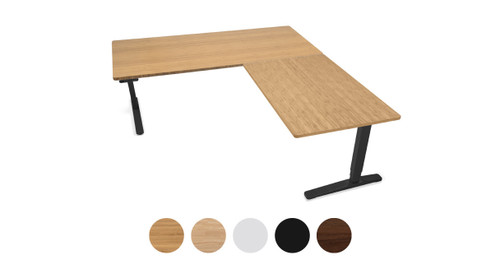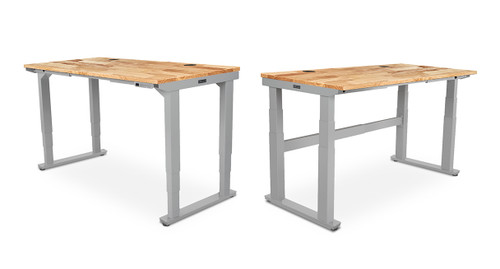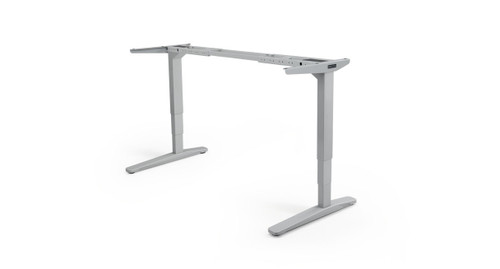
Monitor Arm Buying Guide: How to Choose the Best Ergonomic Monitor Arm
Understanding the difference between monitor arms, monitor stands, a monitor riser, and wall-mount and pole-mounted options can help you figure out which offers the best solution for your needs. What do you need to know when choosing the best ergonomic monitor arm for you?
- Does your monitor arm have VESA mounting capability?
- How much does your monitor weigh?
- How do you want to attach the arm to your desk?
Want help? Use our Ergonomic Monitor Arm Selector Tool and one of our fit experts will respond with personalized recommendations. We love to help people find exactly what works for their needs, and we typically respond within 1 business day. Wondering how high your monitors should be? You can use our Ergonomic Office Desk, Chair and Keyboard Height Calculator to find the correct monitor height for you.
What is a Monitor Arm?
A monitor mount or arm offers a sturdy, semi-permanent placement, and an LCD arm usually has articulating arms or links that allow for a much wider range of monitor placement, are easily rotated for collaboration and free up valuable desk space. They can come with one arm, a dual monitor arm, or even more arms - depending on your use. An articulating LCD monitor arm can also accommodate multiple monitors, for multiple users on one post.
Articulating arms - must be mounted to the work surface, the wall, a slat wall or slat panel. The range of adjustment will vary widely by the arm selected, but in general:
- Height adjustment - can be accomplished in a number of ways depending on the arm. Most LCD arms will use one or more of these methods for height control:
- Gas/pneumatic cylinder - These allow you to adjust the height of the arm by sliding the pole down. These cylinders are calibrated to the monitor weight and must be ordered appropriately by the weight of your monitor.
- Fingertip control - the links (the arm between the pole and monitor) can move up and down simply by moving the monitor with your hands. monst fingertip-adjustable monitor arms have gas or pneumatic cylinders.
- Knob or Pole mount - the links are attached to the pole by way of a bracket that can be slid up or down the pole to set height. This is best for "fix it and leave it" installations as reaching to the pole to change your monitor height is not optimal if you reposition your monitor often
- Depth adjustment - the range of distance between the post and the monitor is changed by pushing your monitor back or pulling it forward. How much distance you can acheive is determined by the length of the arm you have purchased and can vary from 8" to more than 24". We offer several models with extended reach arms. Arms must fold to push your arm closer to the post. Some arm links will fold one on top of the other and these are better suited if you wish the flexibility to move your monitor as close as possible to the post.
- Rotation - an articulating LCD monitor arm will allow you to quickly adjust your monitor from landscape to portrait positioning. Most offer 360° rotation so you can quickly rotate your monitor to share information with a customer or coworker. Some arms offer a wider range of rotation at multiple pivot points.
- Tilt - all arms offer some tilt for viewing comfort but some models offer a greater tilt range for varying working positions and some now offer as much as 200° tilt to accommodate new, touch screen monitors as well as tablet PCs (wth an adapter to hold the tablet)
- Modularity - most monitor arms are not reconfigurable, but some are. Ergotech LCD arms, mounts and stands, and some Innovative arms can be reconfigured to accommodate additional monitors, or change mounting method.
What is a Monitor Stand?
Monitor stands sit on your desktop and offer maximum portability as you can pick it up and move it at any time. While an LCD monitor arm must be mounted to your desk to be secure and keep your monitors safe, a monitor stand is instantly portable. In order to move an LCD monitor arm you must remove the monitors, then uninstall the arm, making a monitor stand a good choice if you need to move your monitors from place to place often. Use of an aftermarket stand offers these advantages over the one that may have come with your screen:
- Height adjustability - most stock stands offer some positioning control but no height adjustment. You may need the ability to raise or lower your monitor. Depth of placement of monitor is controlled by moving the stand.
- Increase angle adjustments - after market stands offer sophisticated pivot mechanisms that let you change both the angle and tilt of your screen for optimal positioning. Ergonomists recommend tilting the top of your monitor away from you slightly, this is impossible on many stock stands.
- Rotation - most stands will allow you to view your monitor in either landscape or portrait layout.
- Multiple monitors - this is where after market stands really shine as you can mount up to four monitors on one stand, for easy positioning and mobility.
- Modularity - many aftermarket monitor stands are fully modular so your changing needs, for example a larger monitor or the addition of a second (or third, etc.) monitor, can be handled with the purchase of a few extra parts, extending the value of your original stand purchase.
What is a Wall or Post Mount?
Monitor mounts are posts that must be mounted to a wall, slatwall, slat panel or work surface and offer direct mount of your LCD monitor without an articulating arm.
- Height adjustment - is accomplished by moving the monitor bracket up or down the pole, if your chosen model has a pole. Many wall or panel mount LCD monitor mounts do not have a pole or offer height adjustability.
- Depth adjustment - is usually not available on an LCD monitor mount.
- Rotation - varies by model
- Tilt - varies by model








